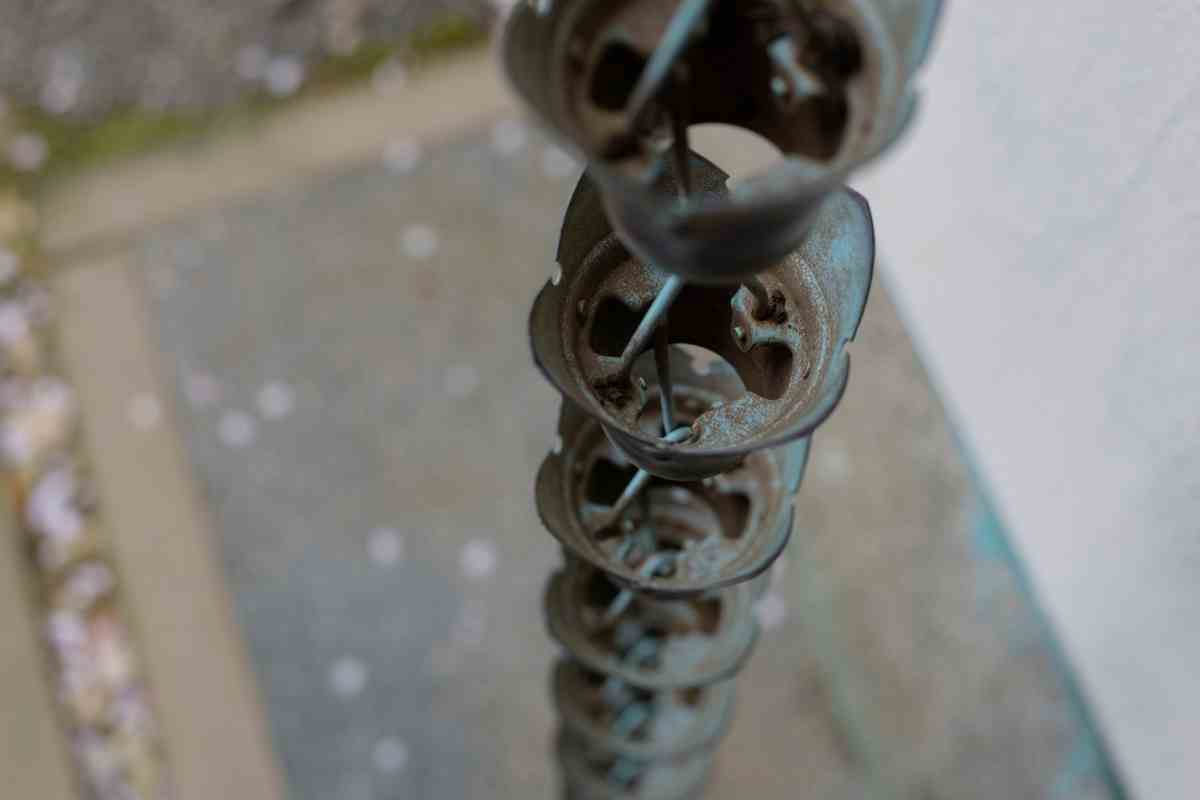Draining rainwater from your property is essential to its structural integrity. If water is allowed to pool on the roof or run down the walls, it will eventually cause rot and costly damage.
That’s why most of us have guttering systems installed on our homes but what if there was a more attractive way to get the job done?
Well, there is; the garden rain chain. These are an alternative to your downspouts and are incredibly common in places like Japan.
However, in the western world, more and more people are becoming enamoured with the rain chain.
So, if you have been considering getting some, here comes your complete guide on everything you need to know.
What Is A Rain Chain?
As we have already mentioned, a rain chain is an alternative to the downspouts that are part of your guttering system on your house.
They originally come from Japan and here, they are called kusari-doi.
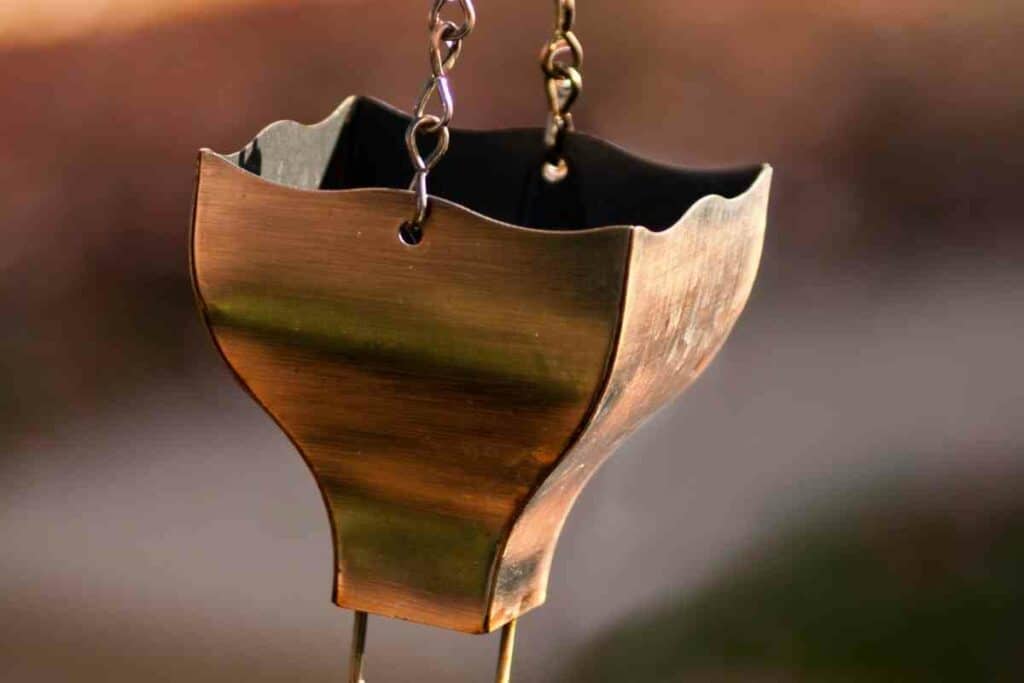
You’ll be more likely to see them than a downspout in this country as they’ve been used for centuries on all kinds of Japanese buildings including temples.
The way that rain chains work is that water flows into the horizontal gutter along the edges of the roof and instead of then going through a downspout, the water runs down the rain chain.
At the bottom, you will have something to collect the water.
This could be a barrel, drain or anything else.
Are Rain Chains Durable In Bad Weather?
One of the main things that concerns people about using a rain chain instead of a downspout is that they won’t work as well in very extreme weather.
In places with a lot of heavy rainfall, you could be forgiven for looking at a rain chain and thinking that it wouldn’t be very effective.
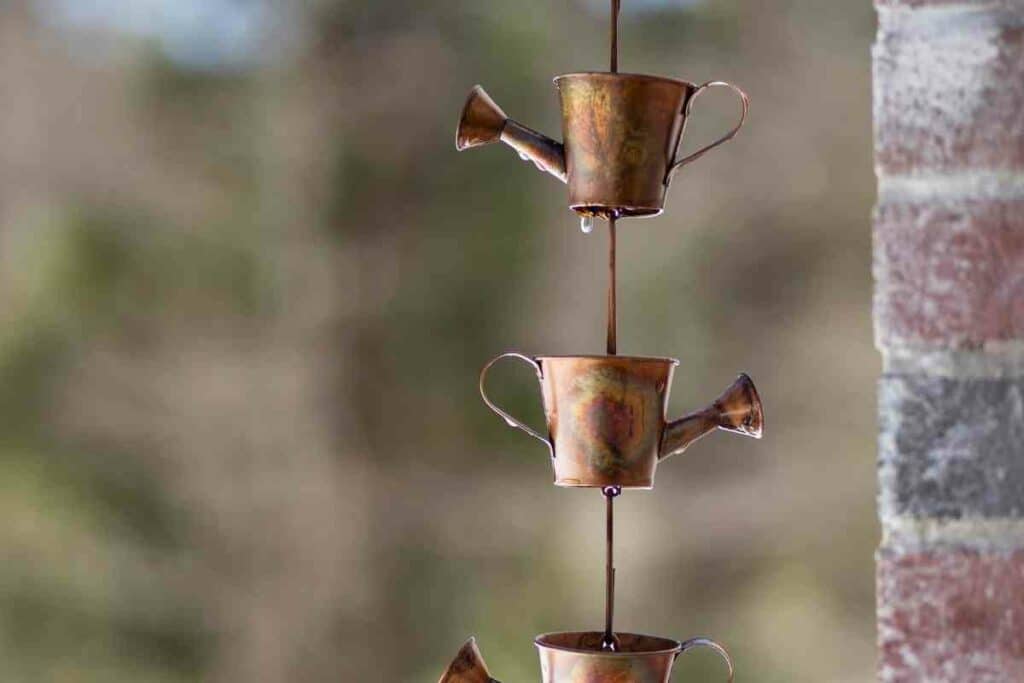
The good news is that this is far from the truth and a rain chain works just as well in heavy rain as even the best downspouts.
What’s More – A lot of people that use them claim that they are much easier to maintain as debris like leaves, from bad weather, isn’t as likely to get stuck in them as it is in a downspout.
They’re also suitable for use in windy conditions since they are placed close to your house so have a good deal of protection from the wind.
That said, it is possible to secure them to the ground at the lower end if you are in any way concerned.
Can You Use A Rain Chain Without A Gutter?
While it is possible to use a rain chain without a gutter, it might not be the most functional option.
If you live in an area where there isn’t very much rainfall then it would be easier to use the rain chain without a gutter.
However, for most people, you would need to consider the type of rain chain you’ll be using.
The link style chains aren’t able to collect as much water as a cup style chain which would be better if there is anything other than minimal rainfall.
But it’s also worth figuring out how your roof behaves when water is on it.
Try running your garden hose onto the roof and looking at whether the water pools in a particular location and how it runs off.
This will give you a better idea of where to place your rain chain for the most effectiveness.
Types Of Garden Rain Chains

When it comes to rain chains, you do have options.
We touched on this in the previous section but let’s take a look at the different types of rain chains:
- Traditional rain chains feature a link design. This is the closest thing to a chain that you could get. The water runs down the chain and into a receptacle at the bottom.
- There are cup chains which have small cups along the length. These cups have holes in their bases so that water can pass through. Generally speaking, there will be a cup around every six inches along the chain.
- There are also highly decorative rain chains that come in a whole host of styles and colors. If you’re looking for a rain chain to boost the aesthetic of your home then this is a brilliant option.
What Are The Benefits Of Rain Chains?
There are so many great things about the rain chain and that’s likely why it has become a popular choice way outside of Japan.
If you’re still sitting on the fence as to whether to use rain chains, these advantages might help you make a decision.
For Starters – They really boost the curb appeal of your home. There’s no denying that a downspout isn’t the most attractive item but it’s functional nonetheless.
However, rain chains are beautiful and can make your home look much more visually appealing.
On top of this, rain chains create a pretty tinkling sound as the water passes through them which is beautifully relaxing.
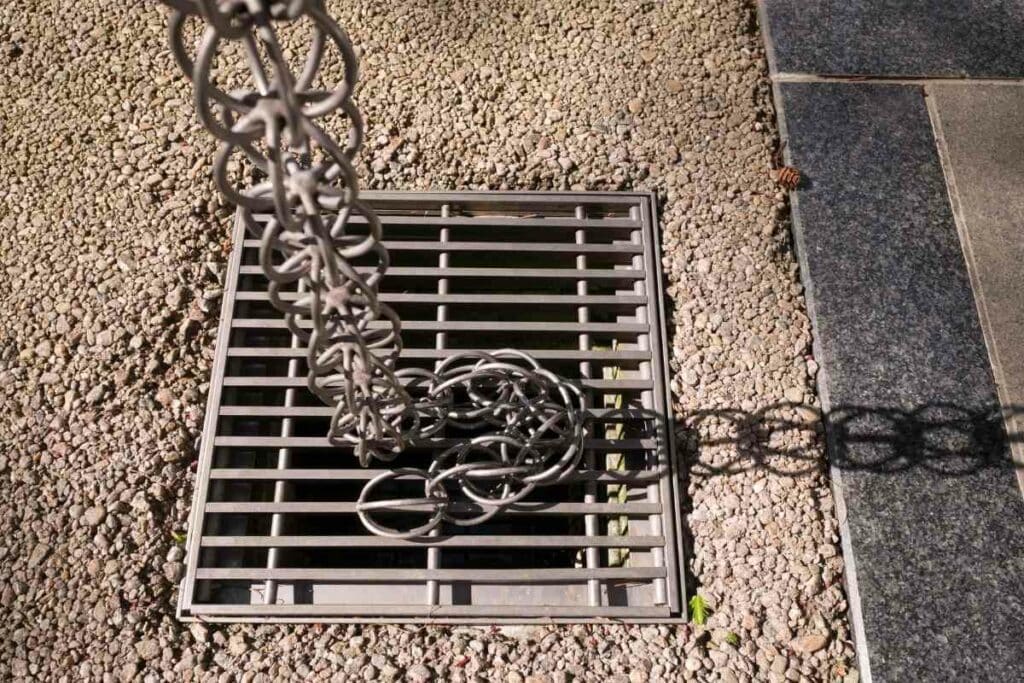
On top of this, rain chains are very robust since they are typically made from copper.
This is far more durable than something like plastic or vinyl from which a downspout is made so you’ll get a longer lifespan.
Looking after your rain chains is so easy. As we mentioned earlier, they don’t tend to get blocked by debris so they’re much easier to clean.
Plus, they’re also super easy to install but we will look at that in more detail later on.
Even Better – A lot of people are under the impression that rain chains are expensive but this isn’t true at all. In fact, they’re pretty affordable so you won’t need to worry about breaking the bank.
Installing A Rain Chain
It’s perfectly possible to hire a professional to come and fit your rain chains for you.
However, there’s really no reason to spend the extra money when installation is a breeze. If you have basic DIY skills then you should find the job pretty easy.
Everything you need to install the rain chain correctly will come with the product. This includes things like clips to secure the chain to the existing gutter.
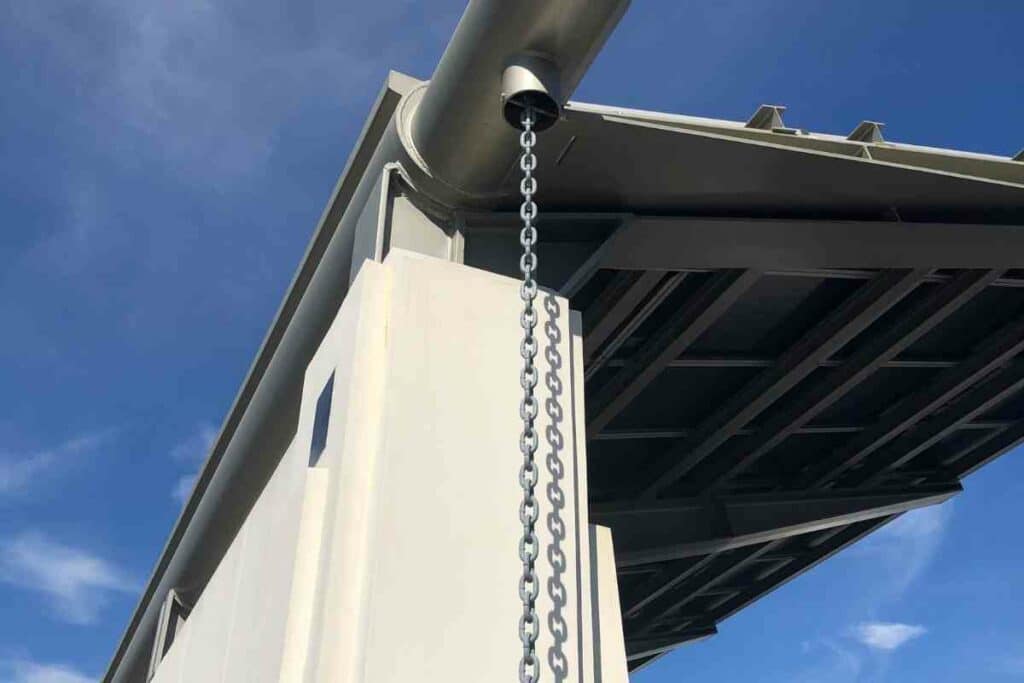
The only additional thing you might like to add are some pebbles and stones to cover the drain at the base which is what they traditionally do in Japan for aesthetic purposes.
Upon buying your rain chain, you’ll have all the necessary equipment, as we mentioned, However, you will need to gather a few essential tools.
These include:
- Tin snips
- Leaf filter
- Gravel, pebbles or stones
- Hacksaw
- Hanging bar
- Gloves
- Tape measure
Step 1
The first thing you need to do when installing your rain chain is to choose a suitable location.
As we discussed earlier on, it’s a good idea to pay some attention to how water behaves on your roof as this will allow you to choose the best place.
And of course, don’t forget that you can install as many rain chains as you’d like.
After all, you don’t only have one downspout on your house, do you?
Also try to keep in mind where the rain chain will empty:
- Is there a drain you can place it over?
- Would you prefer to use a rain barrel?
Some people even place them over plants that require a lot of water which is a great way to use rain in an eco friendly manner.
Step 2
Next, you will need to remove the downspouts from your guttering system.
This may seem extreme but your rain chains are going to replace these downspouts so it’s an important step.
Step 3
Once you have removed the downspouts, you may need to make an opening for your rain chain.
This is where your tin snips come in handy but be sure to make the opening the correct size.
After you have done this, you can then attach your hanging bar which is shaped like a V and gives you something to attach the chain to.
Using a copper bar is best as this will ensure the correct amount of strength needed to support the chain even when it is filled with water.
Step 4
It’s not time to hang your rain chain but be careful to follow the instructions included with the product as this will allow you to hang it in the most efficient manner.
Once you have successfully hung the chain, you can now alter the length.
You might not need to do this but in many cases you will. It’s important to adjust the length where needed as this will ensure that the rain chain functions correctly.
Step 5
It isn’t always necessary but sometimes, you may need to secure the bottom of the rain chain at ground level.
This would normally be in areas where there is a lot of wind so make sure you choose an anchor that will keep the rain chain from blowing around or falling down.
4 Tips On Choosing A Rain Chain
There isn’t too much difference between rain chains and at the end of the day, they are all designed to do the same thing.
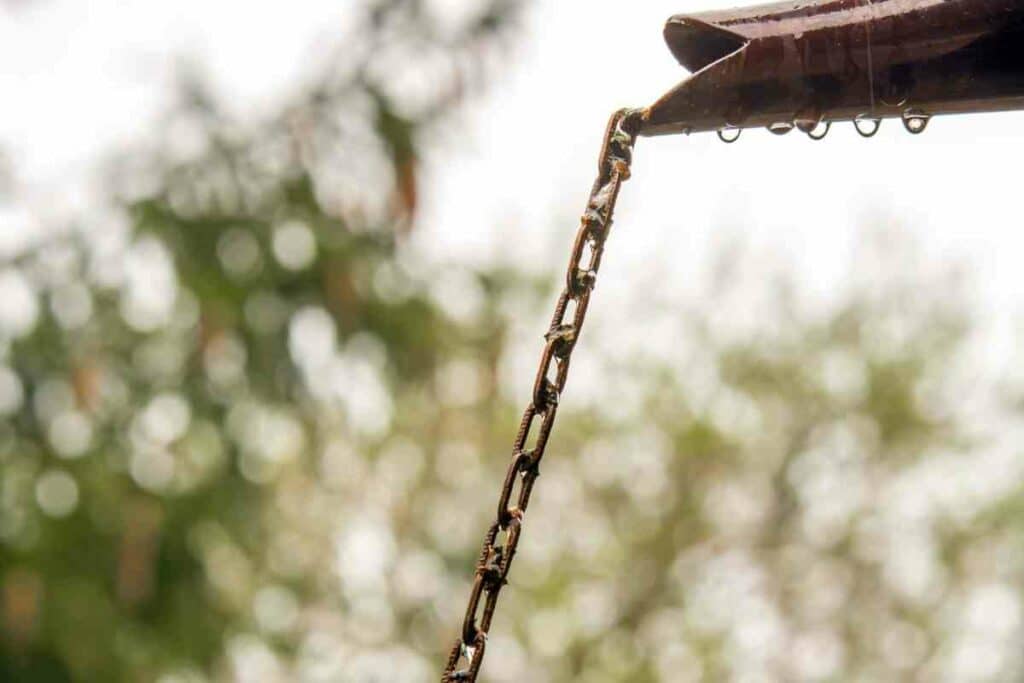
However, there are plenty of different designs to choose from so it is worth considering your options before making a final decision.
1. Design
One of the first things to think about when choosing a rain chain is the design.
Earlier, we talked about the link and cup designs.
If you live in an area with less rainfall then a traditional link style might be OK whereas areas with heavier rain may benefit from a cup style rain chain.
2. Place
You should also consider where you are going to place the rain chain as this can influence your decision when it comes to what type you’ll use.
If you’re going to place the chain near a window or door then a cup style is going to work better as there will be less splashing.
On the other hand, if there are plants nearby that need water, a link design will splash onto them.
3. Materials
Another important consideration is the material from which your rain chain is made.
Most of the time, they are made from copper but you can also get rain chains made from aluminum and steel.
The reason that most people would consider copper to be the best option is that it is far less prone to rust damage so the chain will stand the test of time.
However, you should keep in mind that the copper will eventually turn green as it ages.
4. Installation
The final, and potentially most important thing to think about when choosing a rain chain is how easy it is to install.
If you want to avoid spending extra cash on hiring someone to install it for you then you’ll need something that’s easy as a DIY project.
Choosing a product with a full installation kit is going to make life much easier!
Conclusion
Rain chains are a beautiful alternative to downspouts and can give your home a really aesthetic boost.
Not only that but they’re incredibly effective and can be used in all kinds of weather so it doesn’t matter if there’s a lot of heavy rainfall in your area.
With different designs to choose from and easy installation, it’s no wonder that rain chains have become so popular.
